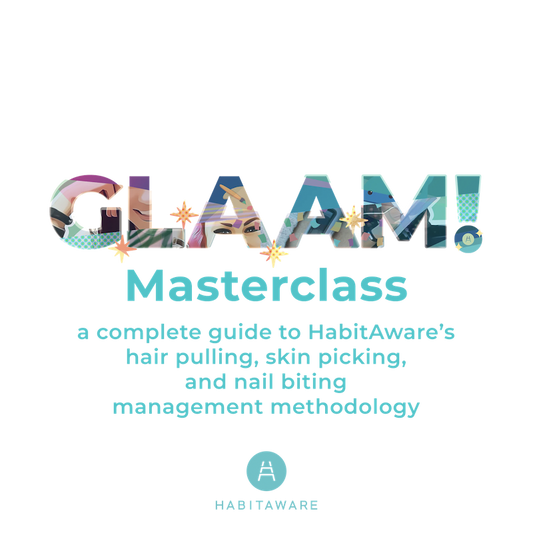Trichotillomania is a body-focused repetitive behavior.
-

Trichotillomania
Compulsive Hair Pulling
-

Dermatillomania
Compulsive Skin Picking
-

Onychophagia
Compulsive Nail Biting
-
Mayo Clinic Defintion
Trichotillomania(trik-o-til-o-MAY-nee-uh), also called hair-pulling disorder, is a mental disorder that involves recurrent, irresistible urges to pull out hair from your scalp, eyebrows, or other areas of your body, despite trying to stop.
-
Common Hair Pulling Regions
A person might pull hair from just one body site, or multiple. Common body sites include pulling from the scalp, pubic hair, arm/leg hair, beard hair, eyebrows/eyelashes, and armpit hair.
Common Trichotillomania Myths
Is Trichotillomania a choice?
Trichotillomania and other body-focused repetitive behaviors ARE NOT A CHOICE! They are chronic medical conditions. It is easy for people to blame those with Trichotillomania for not being able to control their hands, but that ignores the fact that Trichotillomania stems from the "fight-or-flight" nervous system, making it a naturally ingrained behavior in the body and thus not a choice. It's the body's default response to trying to get it back to "center." It's not the individuals choice to have these urges, and they cannot usually be controlled through sheer willpower. That's why management is so important.
Is Trichotillomania an addiction?
While hair pulling may provide a sense of relief or pleasure for people with Trichotillomania, it is not an addiction in the traditional sense. People with Trichotillomania do not compulsively pull their hair out in order to reach an altered state of consciousness, they do it because their subconscious mind is looking to self-soothe.
Is Trichotillomania the same as Obsessive-Compulsive Disorder?
While hair pulling may be symptomatic of another mental health condition, Trichotillomania is actually considered its own disorder. That's important to know because the treatment for OCD, ADHD, and BFRBs are all different.
Is Trichotillomania a rare condition?
While Trichotillomania may be lesser known than other mental health conditions, it is actually quite common. It is estimated that around 3.5% of the population suffers from this disorder, which means that there are potentially millions of people who struggle with it.
Trichotillomania can affect people of all ages, genders, and races.
Can Trichotillomania be cured?
There is currently no cure for Trichotillomania, but there are ways to manage the symptoms and urges. The most effective treatment options include cognitive-behavioral therapy (CBT) and habit reversal training (HRT). There are also awareness smart bracelets, and online support. These resources focus on helping people learn new coping strategies for dealing with stress and other triggers that may cause them to pull their hair.
Ready for a change? Join the Keen family:
-
 Sale
SaleKeen2 Bracelet
Regular price $149.00 USDRegular priceUnit price per$179.00 USDSale price $149.00 USDSale -
BFRB Recovery Starter Class
Regular price $99.00 USDRegular priceUnit price per$159.00 USDSale price $99.00 USDSale -
Virtual Peer BFRB Coaching
Regular price $240.00 USDRegular priceUnit price per$300.00 USDSale price $240.00 USDSale -
HabitAware's Mindset Masterclass
Regular price $129.00 USDRegular priceUnit price per$199.00 USDSale price $129.00 USDSale
Trichotillomania FAQ
-
How do I stop pulling out my hair?
There's no one right way to manage Trichotillomania. But here are some suggestions:
• Speaking to a treatment professional.
• Joining an online support group.
• Growing your awareness with an awareness bracelet.
• Creating a personalized Management Strategy.
-
How do I tell people about my Trichotillomania?
It can be hard to talk about your Trichotillomania, even with a loved one, because of how much stigma there is around the condition.
That being said, support is important when learning to manage.
Here's our guide for preparing to tell a loved one about your Trichotillomania.
-
What are the best replacement strategies for Trichotillomania?
You are unique, and will likely have your own favorites! Experimentation is the best way to figure out what works for you.
TED | Overcoming Trichotillomania with the power of Keen Awareness:
-

What is Trichotillomania?
Read the BlogThe textbook clinical definition:
Trichotillomania (trik-o-til-o-MAY-nee-uh), also called hair-pulling disorder, is a mental disorder that involves recurrent, irresistible urges to pull out hair from your scalp, eyebrows, or other areas of your body, despite trying to stop.
-

Conquering with Keen - Mae's Story: Growing Hair and Confidence
Read the BlogMae, 18 years old and from South Carolina, has been dealing with Trichotillomania for 3 years. This is how she’s Conquering with Keen, in her own words.
"I have been dealing with Trich for a little over 3 years now..."
-

Why I Freed Myself from a “Pull Free” Mindset
Read the BlogAs one of more than 10,000 members of an online Trichotillomania support group, there isn’t a day that goes by that someone doesn’t vow to go pull free, or share how many days, weeks, months or years they are celebrating being pull free.










